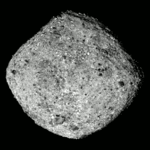Astronomy:EPIC 211945201 b
 A high angular resolution image EPIC 211945201 taken using the NIRC2 instrument on the 10m Keck II telescop | |
| Discovery | |
|---|---|
| Discovery date | May 10, 2017 |
| Transit | |
| Designations | |
| K2-236 b | |
| Orbital characteristics | |
| 0.148 AU | |
| Orbital period | 19.4921 day |
| Inclination | 87.9° |
| Semi-amplitude | 5.7 m/s |
| Physical characteristics | |
| Mean radius | 0.546 RJ |
| Mass | 0.085 MJ |
| Physics | 886.35 K |
EPIC 211945201 b is a Neptune-like exoplanet that orbits an F-type star. It is also called K2-236b. Its mass is 27 Earths, it takes 19.5 days to complete one orbit of its star, and is 0.148 AU from its star. Its discovery was reannounced in 2018.[1] This was the first exoplanet discovered by scientists based in Physical Research Laboratory, Ahmedabad, India. The discoverers were Abhijit Chakraborty (PRL), Arpita Roy (Caltech), Rishikesh Sharma (PRL), Suvrath Mahadevan (Penn State), Priyanka Chaturvedi (Thüringer Landessternwarte Tautenburg), Neelam J.S.S.V Prasad (PRL), and B. G. Anandarao (PRL).[2]
Overview
The exoplanet EPIC 211945201 b was discovered in 2018 using the transit method. Using this method, astronomers can see everything from methane to water vapor on other planets by photometry.[3] It is the only planet orbiting around EPIC 211945201, a G0 class star, situated in the constellation of Cancer in 596 light-years from the Sun. Its host star is aged 4 billion years. EPIC 211945201 b orbits its star in about 19 terrestrial days.[4] It orbits closer to the star than the internal limit of the habitable zone. It has a low density and may be composed of gas. It has a low Earth similarity index (0.14) and should be very different from our planet.
Discovery
EPIC 211945201 b was found to be a planetary candidate from K2 photometry in Campaigns 5 & 16. The exoplanet transits the bright star (Vmag = 10.15, G0 spectral type) in a 19.492 day orbit. The photometric data combined with false positive probability calculations using VESPA may not be sufficient to confirm the planetary scenario but high-resolution spectroscopic are taken using the PARAS spectrograph (19 radial velocity observations) over a time-baseline of 420 days.[2]
The data shows that the planet has a radius of 6.12 ± 0.1 R⊕, and a mass of 27+14
−12.6 M⊕. It consists of a density of 0.65+0.34
−0.30 g/cm3. Based on the mass and radius, it estimates that the heavy element content is 60-70 % of the total mass.[2] The surface temperature of the planet was found to be around 776.35 K, as it is very close to the host star.[5] It is seven times nearer to its star, in comparison with Earth-Sun distance. This shows that the extra-solar planet is in the uninhabitable zone. The discovery is of importance for understanding the formation mechanism of such super-Neptune or sub-Saturn kind of planets, that are too close to the host star, according to scientists.
See also
- List of potentially habitable exoplanets
- List of exoplanet firsts
- List of exoplanetary host stars
- List of exoplanets discovered using the Kepler spacecraft
- List of planets observed during Kepler's K2 mission
- List of nearest terrestrial exoplanet candidates
References
- ↑ "EPIC 211945201 b | New World Atlas - Exoplanet Exploration: Planets Beyond our Solar System". https://exoplanets.nasa.gov/newworldsatlas/6307/epic-211945201-b/.
- ↑ 2.0 2.1 2.2 Chakraborty, Abhijit (May 10, 2017). "Evidence of a Sub-Saturn around Epic 211945201". The Astronomical Journal 1 (1805.03466): 3. doi:10.3847/1538-3881/aac436. Bibcode: 2018AJ....156....3C.
- ↑ "5 Ways to Find a Planet". https://exoplanets.nasa.gov/5-ways-to-find-a-planet/#/2.
- ↑ Telechev, Anton. "Exoplorer: epic-211945201-b" (in en). http://exoplorer.org/en/exoplanets/epic-211945201-b.
- ↑ "The Extrasolar Planet Encyclopaedia — HATS-36 b". http://exoplanet.eu/catalog/hats-36_b/.





